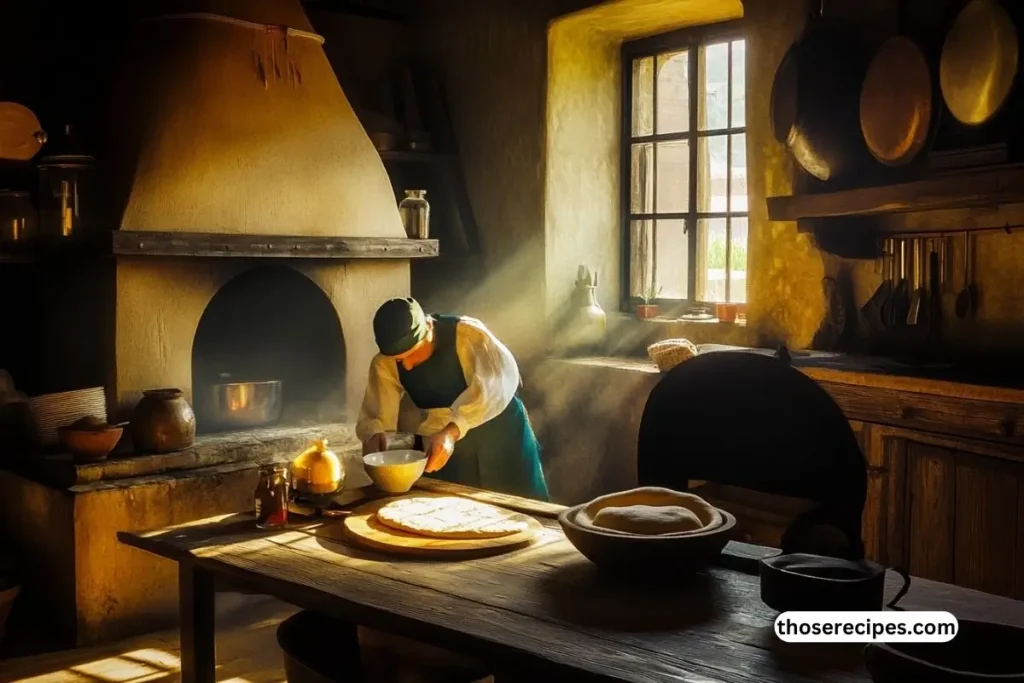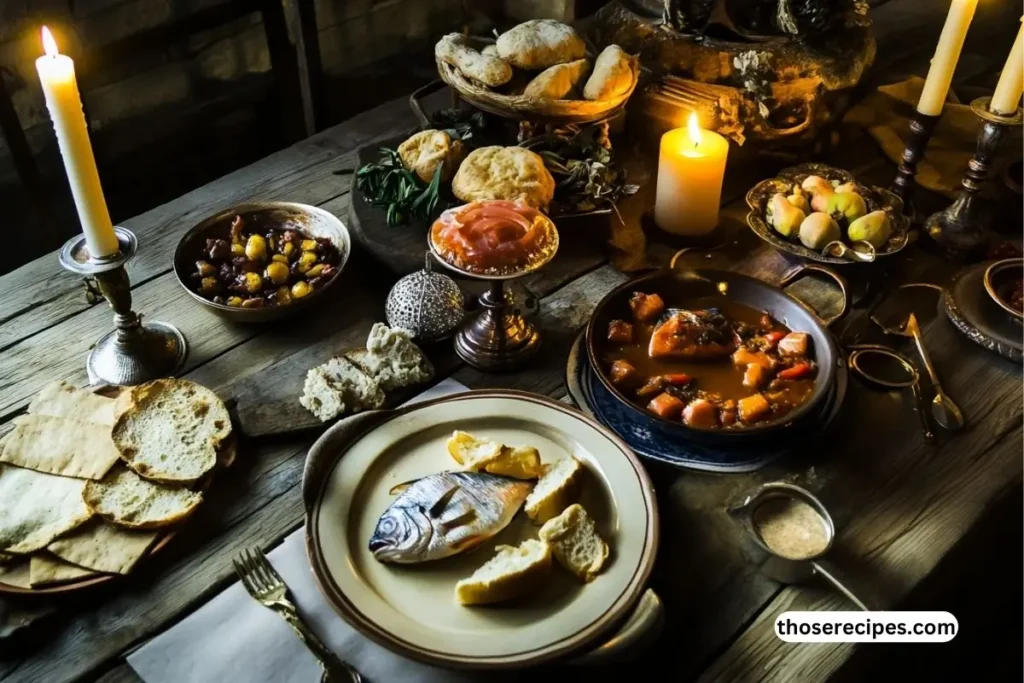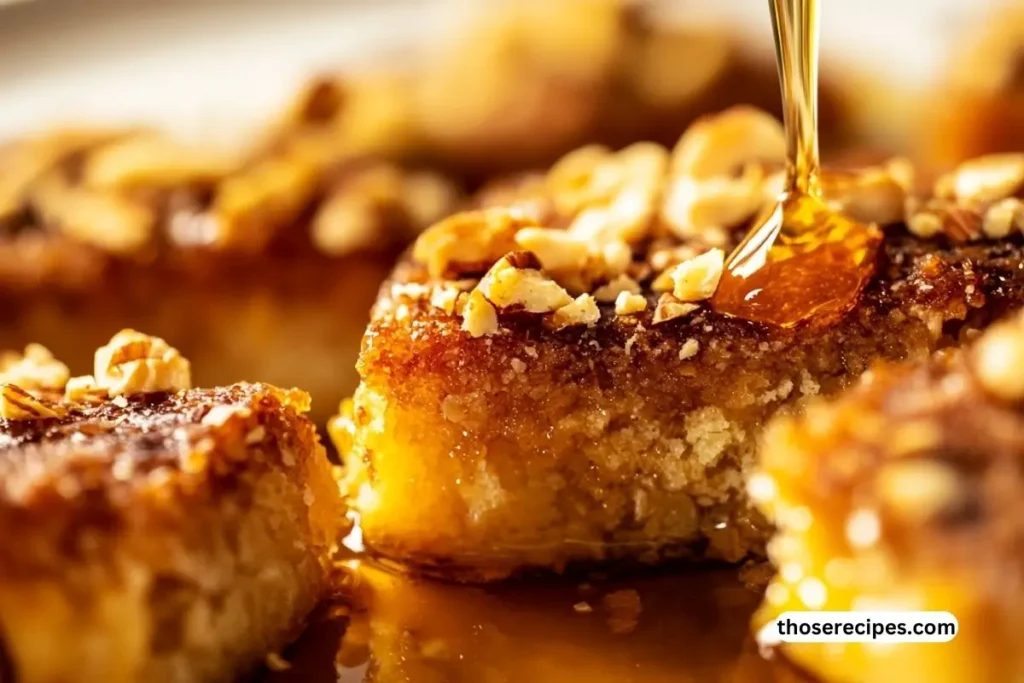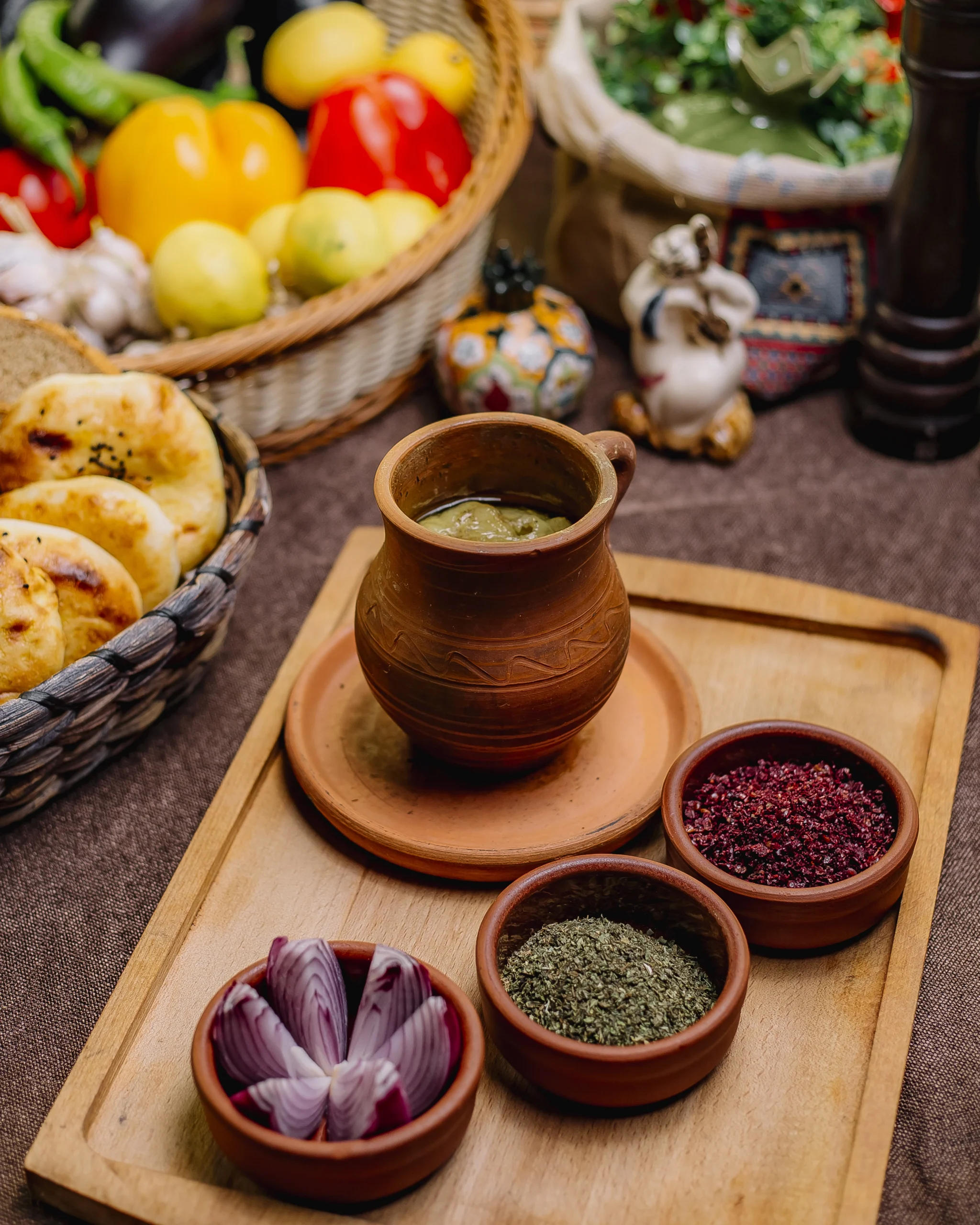Table of Contents
The Byzantine Empire, a beacon of culture and innovation for over a millennium, shaped history in many ways. Among its fascinating contributions, Byzantine recipes blended Mediterranean staples, Roman traditions, and Eastern influences into a unique and rich culinary tradition. These recipes offer a flavorful glimpse into the lives of one of antiquity’s most sophisticated civilizations.
In this article, we’ll explore the ingredients, cooking methods, and iconic dishes of the Byzantine Empire while uncovering how its culinary practices influence modern gastronomy.
The Historical Significance of Byzantine Recipes and Cuisine
How Byzantine Cuisine Reflected Culture and Innovation
The cuisine of the Byzantine Empire was far more than nourishment—it mirrored the Empire’s wealth, religious customs, and cultural connections. Byzantine recipes showcased an intricate fusion of Mediterranean staples, imported spices, and creative techniques.

The Role of Byzantine Cooking in Daily Life
Food in the Byzantine Empire served as a marker of social status:
- The Elite: Wealthy citizens hosted elaborate feasts featuring exotic ingredients and multi-course meals. These gatherings displayed their affluence and political power.
- The Common People: Everyday meals relied on staples like bread, legumes, and vegetables. Despite their simplicity, these dishes sustained laborers and peasants.
Religion also shaped Byzantine cooking. Orthodox Christianity imposed dietary restrictions during fasting periods, encouraging the creation of vegetarian and seafood-based dishes. Feasting during religious celebrations, on the other hand, highlighted the richness of Byzantine cuisine.
Ingredients in recipes from the byzantine empire: A Global Culinary Influence
Staple Ingredients in Byzantine Cooking
Byzantine recipes utilized a diverse array of ingredients:
- Grains: Wheat, barley, and oats formed the foundation of many meals.
- Olive Oil: This essential ingredient served as a base for cooking, preservation, and even religious rituals.
- Honey: The primary sweetener in desserts and savory dishes alike.
- Legumes: Lentils, chickpeas, and beans provided protein.
- Dairy Products: Cheeses, yogurts, and milk appeared regularly in the diet.
- Spices: Cinnamon, cloves, pepper, and nutmeg added exotic flavors, especially to dishes prepared for the elite.
Regional Variations in Byzantine Culinary Traditions
The Empire’s vast geography influenced the use of ingredients:
- Coastal regions relied on fresh seafood, including fish and shellfish.
- Inland areas featured preserved meats, dried fruits, and dairy products.
- Trade routes brought luxury ingredients like saffron and cinnamon, enriching the Byzantine culinary repertoire.
Learn more about Mediterranean ingredients that played a pivotal role in Byzantine recipes through this article.
Byzantine Cooking Techniques and Tools
Traditional Methods in Byzantine Cuisine
Cooks in the Byzantine Empire used methods that highlighted the natural flavors of their ingredients:

- Boiling and Stewing: Ideal for porridges, soups, and fasting dishes.
- Roasting and Baking: Commonly used for meats, breads, and desserts like honey cakes.
- Frying: Occasionally used for fish and dough-based desserts.
- Fermentation: Essential for preserving fish, vegetables, and grains.
Kitchen Tools That Brought Byzantine Recipes to Life
- Clay ovens were indispensable for baking bread and roasting meats.
- Iron pots and pans supported stewing and boiling.
- Mortars and pestles allowed cooks to grind spices and prepare sauces, essential for Byzantine recipes.
Iconic Byzantine Recipes and Their Modern Adaptations
Flatbread and Other Essential Byzantine Dishes
Lagana Flatbread
- Description: A simple, unleavened bread made with flour, water, and olive oil.
- Cultural Significance: People traditionally ate lagana during fasting periods. Greeks still enjoy it on Clean Monday.
- Preparation Tips: Add sesame seeds or herbs for extra flavor. Serve with olive oil and vinegar as a dip.
Sweet Treats in Byzantine Cuisine: Honey Cakes
Byzantine Honey Cakes (Melitouta)

- Description: Sweet cakes combining honey, nuts, and spices.
- Festive Role: These cakes symbolized prosperity during celebrations.
- Modern Twist: Use all-purpose flour instead of ancient grains for easier preparation.
Seafood Stews and Savory Porridges
Fish Stew with Herbs
- Description: A hearty stew featuring fish, olive oil, and fresh herbs.
- Regional Popularity: Coastal communities favored this nutritious and flavorful dish.
- Modern Pro Tip: Add white wine to enhance the flavor.
Savoury Porridge
- Description: Cooks prepared this versatile dish by boiling grains with vegetables, herbs, and sometimes meat.
- Cultural Role: This dish exemplified the resourcefulness of Byzantine cooking, serving as a staple for all social classes.
The Legacy of Byzantine Recipes in Modern Cuisine
How Byzantine Recipes Influenced Mediterranean and Middle Eastern Cooking
The legacy of recipes from the byzantine empire extends far beyond its historical timeline. Through trade and cultural exchange, the Empire’s culinary practices shaped neighboring cuisines:
- European Influence: Techniques like bread-making spread across Europe, laying the groundwork for many modern recipes.
- Middle Eastern Connections: Shared dishes like honey cakes and savory stews bridged Byzantine and Arabic cultures.
- Fusion of Flavors: Byzantine cuisine represents an early example of global gastronomy, blending influences from Asia, Africa, and Europe.
Preserving Byzantine Culinary Traditions Today
Modern chefs and historians work tirelessly to recreate and adapt ancient Byzantine recipes. This effort ensures the survival of a culinary tradition that continues to inspire.
Bringing Byzantine Recipes to Modern Kitchens
Recreating Byzantine recipes can be an enriching experience, but it requires adapting to modern ingredients and methods.
Tips for Cooking Byzantine Dishes at Home
- Replace ancient grains like spelt with modern alternatives such as quinoa or farro.
- Embrace the liberal use of olive oil and honey to replicate authentic flavors.
- Experiment with spices like cinnamon and cloves to capture the essence of Byzantine cuisine.
Discover more about recreating ancient recipes through this article.

Recipes from the Byzantine Empire: Ancient Flavors and Traditions
Equipment
- Clay Oven or Modern Oven Used for baking bread and roasting meats.
- Iron Pot or Dutch Oven Ideal for stews, soups, and boiling grains.
- Mortar and Pestle Used for grinding spices, herbs, and making pastes.
- Wooden Spoon Traditional stirring tool for porridge and stews
- Baking Stone or Sheet Helps bake flatbreads like Lagana.
- Cheesecloth or Strainer Useful for making fermented dairy products or straining broths.
Ingredients
- 1 tbsp Olive oil Used for cooking or dressing
- 2 cups Wheat flour Suitable for bread or porridge
- 1 tbsp Honey Natural sweetener used in many Byzantine dishes
- 1/2 tsp Cinnamon Common spice in both savory and sweet recipes
- 1/2 cup Goat cheese Frequently consumed dairy product
- 1 cup Lentils Staple in Byzantine cuisine, especially for fasting
- 1 clove Garlic Used in stews and seasoning
Instructions
- Preheat the oven to 350°F (175°C). Grease a baking pan with olive oil.
- Mix dry ingredients: In a bowl, combine 2 cups wheat flour, ½ tsp cinnamon, and a pinch of salt.
- Prepare the wet mixture: In another bowl, whisk ½ cup honey, 2 tbsp olive oil, and ½ cup warm water until well combined.
- Combine the mixtures: Gradually add the dry ingredients to the wet mixture, stirring until a smooth batter forms.
- Bake: Pour the batter into the greased pan and bake for 25–30 minutes or until golden brown and firm.
- Cool and serve: Let the cake cool before drizzling with extra honey and topping with chopped nuts.
Notes
Recipe Notes:
- Ingredient Substitutions: If wheat flour is unavailable, you can use spelt or all-purpose flour. For a dairy-free option, replace goat cheese with almond-based cheese.
- Flavor Enhancements: Add a pinch of nutmeg or cloves for extra warmth and depth in flavor.
- Serving Suggestions: Serve the dish with fresh fruits, nuts, or a drizzle of honey for an authentic Byzantine experience.
- Storage Tips: Store leftovers in an airtight container at room temperature for up to 2 days or refrigerate for up to a week.
- Historical Insight: This recipe is inspired by ancient Byzantine cuisine, which blended Mediterranean, Roman, and Eastern flavors.
FAQs About Byzantine Recipes and Cuisine
What were the staple foods in recipes from the byzantine empire?
Staples included grains, legumes, olive oil, honey, and a variety of vegetables and fruits.
How does Byzantine cuisine differ from Roman and Greek cuisines?
Although it shares similarities, Byzantine cuisine features a heavier reliance on spices and vegetarian dishes due to fasting practices.
Were spices commonly used in Byzantine recipes?
Yes, spices like cinnamon, cloves, and pepper frequently enhanced the flavors of Byzantine dishes, especially for the wealthy.
Are there modern recreations of Byzantine recipes?
Yes, chefs and culinary historians have recreated many Byzantine recipes using modern techniques and accessible ingredients.
How did religion influence Byzantine cooking?
Orthodox Christianity shaped dietary habits by promoting vegetarian and seafood dishes during fasting periods and encouraging indulgence during feasts.
Conclusion: Celebrating recipes from the byzantine empire and Cuisine
The culinary traditions of the Byzantine Empire offer a rich tapestry of flavors, techniques, and cultural insights. From the simplicity of lagana flatbread to the indulgence of honey cakes, these recipes provide a unique connection to history. By incorporating Byzantine ingredients and methods into modern kitchens, we keep alive a legacy that continues to inspire chefs and food enthusiasts alike.
Whether you’re a historian, a culinary adventurer, or simply someone seeking new flavors, exploring Byzantine recipes opens a window to a time when food was both sustenance and art. Rediscover the tastes of the past and bring the Byzantine spirit to your table today!


2 thoughts on “Recipes from the Byzantine Empire: Ancient Flavors and Traditions”